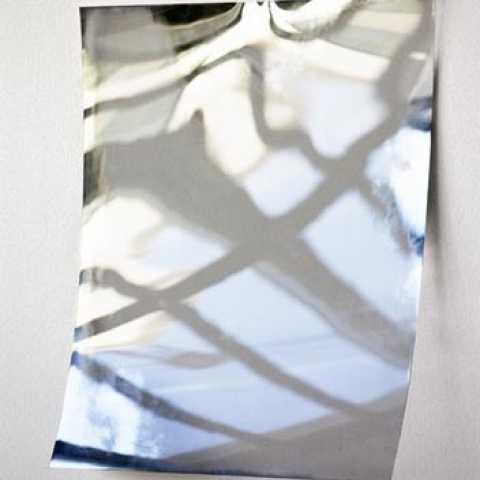
Simply put, Yamaoka's monochromes are the result of pouring, and then waiting. For the viewer there's the experience of seeing the work, and then seeing oneself in the reflective surface.
Of course there's more, much more: in the attempt to situate 'where' you are and then quite what that 'you' 'there' is, the physicalities of both the painting (heavy resin and delicate mylar) and yourself (distorted beyond flesh) are dissolved into the surrounding space in an intimacy that might echo - poignantly, insubstantially - the work of Felix Gonzalez-Torres. Beauty, joy and sadness all commingle. Flesh is made space and space made flesh - an interpenetration of bodies and spaces in a classic confusion of looking and seeing, fixed and shifting.
The minimalist parameters Yamaoka works with are dove-tailed with exquisite precision and the paintings become almost a recording medium as though light had a different speed, was slowed for us to become more familiar with our temporary presence. But light nevertheless reaches the mylar more quickly than we can reach an understanding of its journey... and returns to us in a dizzying moment of loss and recognition.
In the most recent work, she is manipulating the mylar to derive an intermediary field through which we see, playing with ideas of exposure and imprint. Also working more reductively: abrading or erasing the reflective base of the mylar film, and sometimes eliminating the support entirely.
Beyond her existence as a painter Yamaoka shares strong social and political concerns - involved in New York queer/feminist and AIDS activism since the early '90s, the same stretch of time in which she has been exhibiting. And in the space of her paintings (and we must call them that in an act of defiance) where all are one, there is a political decision in taking the strict limitations of proportion, colour and chance, but allowing time to develop at its own pace within them. Included in the work, we must consciously make unfolding acts of interpretation, we are allowed to choose what to distinguish within the painting, and what to let go. Yamaoka has talked of their sculptural essence; as we move round them, as the daylight changes, they cannot stay the same. And nor, of course, can we.
"I am interested in that liminal moment when the freshly exposed photo paper is immersed in the developing tray - when the still latent image begins to form but has not yet coalesced into a recognisable picture... up close there is a lot to see and read on the surface of the painting and within - there are blips and air bubbles, subtle swirling incidents and imperfections arising from a controlled negotiation with chance and process. There is colour, there is texture, there is light that sometimes seems to emanate from the painting. The picture becomes in a sense a record of its own making... â€
